News
Emscher demo case: Real-time-control (RTC) of sewer network ready for implementation
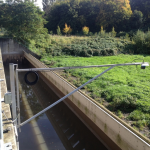 The two demonstration technologies in the Emscher case focus on water quality issues. Aim is to decrease the amount and improve the quality of combined sewer overflow (CSO) into recipient rivers.
The two demonstration technologies in the Emscher case focus on water quality issues. Aim is to decrease the amount and improve the quality of combined sewer overflow (CSO) into recipient rivers.
Five CSO facilities in the upper Emscher river section are now ready for implementation of the RTC system ADESBA. The function of the ADESBA communication software is the optimal utilization of the entire available underground storage volume. The final aim is to reduce pollutant input into streams by reducing the overflow frequency and volume from CSOs into streams. Click to read more
Software for the evaluation of groundwater and surface water interactions: Numerical model tool available
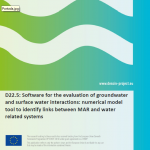
The available document reports the results of the numerical model developed to identify links between MAR and water related systems and to evaluate the impact of Managed Aquifer Recharge (MAR) in general, and Aquifer Storage and Recovery (ASR) in particular, on identified ecosystem services.
The numerical model has two main objectives: to evaluate the interactions between groundwater and surface water media and to become a tool to show the benefits of this technology to implementers. The first objective is approached simulating a typical deltaic aquifer and evaluating the results of different MAR configurations. The latter is done through a web page with the results of the transient simulation in video format. Click to read more
New result available: Assessment reversed osmosis membrane clogging by varying redox conditions of feedwater
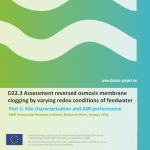 Coastal areas are generally densely populated and marked by high freshwater demands. Due to the proximity of the sea these areas have to deal with saline water intrusions and salinization of groundwater. Therefore the availability of freshwater cannot always be guaranteed in these regions. Use of local ecosystems by aquifer storage and recovery (ASR) of temporary freshwater surpluses and reverse osmosis (RO) of brackish-saline groundwater are potential solutions for freshwater supply in coastal areas. Both techniques have their drawbacks. ASR in coastal aquifers is marked by freshwater losses by buoyancy effects in the saline groundwater, while RO is accompanied by a saline waste water stream. Click to read more
Coastal areas are generally densely populated and marked by high freshwater demands. Due to the proximity of the sea these areas have to deal with saline water intrusions and salinization of groundwater. Therefore the availability of freshwater cannot always be guaranteed in these regions. Use of local ecosystems by aquifer storage and recovery (ASR) of temporary freshwater surpluses and reverse osmosis (RO) of brackish-saline groundwater are potential solutions for freshwater supply in coastal areas. Both techniques have their drawbacks. ASR in coastal aquifers is marked by freshwater losses by buoyancy effects in the saline groundwater, while RO is accompanied by a saline waste water stream. Click to read more
Faces behind the project – Gerard van den Berg
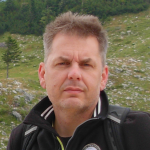 My name is Gerard van den Berg. I have a PhD degree in Geochemistry from Utrecht University in The Netherlands. Since 2004, I work at KWR Watercycle Research Institute. Currently, at KWR, I am manager of the team Innovation & Valorisation and project manager for all our international activities. Our team consists of a group of nine professionals who are responsible for the day to day management of the national and international research programmes of KWR, as well as the international networks of KWR, including Watershare®. I am also Coordinator of the EU funded SUBSOL project, that aims to bring water solutions to market. Click to read more
My name is Gerard van den Berg. I have a PhD degree in Geochemistry from Utrecht University in The Netherlands. Since 2004, I work at KWR Watercycle Research Institute. Currently, at KWR, I am manager of the team Innovation & Valorisation and project manager for all our international activities. Our team consists of a group of nine professionals who are responsible for the day to day management of the national and international research programmes of KWR, as well as the international networks of KWR, including Watershare®. I am also Coordinator of the EU funded SUBSOL project, that aims to bring water solutions to market. Click to read more
Two DESSIN showcases featured at EIP Market Place
 Transforming DESSIN’s demo-sites into showcases has the purpose to establish reference sites for lighthouse-solutions that can be presented to various audiences such as interested water managers from other regions with similar challenges. That, in return, will promote the market uptake of the innovative solutions from DESSIN.
Transforming DESSIN’s demo-sites into showcases has the purpose to establish reference sites for lighthouse-solutions that can be presented to various audiences such as interested water managers from other regions with similar challenges. That, in return, will promote the market uptake of the innovative solutions from DESSIN.
DESSIN scientist Dr. Koen Zuurbier (KWR) graduates at TU Delft on findings from the Westland demo site
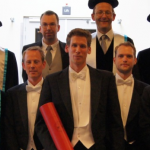 On May 10, Koen Zuurbier obtained his doctoral degree at the TU Delft on his findings during his research on ‘Increasing Freshwater Recovery upon Aquifer Storage’. The DESSIN Westland demosite was one of the pilot sites where a dedicated configuration of groundwater wells was installed to improve the recovery of rainwater surpluses stored in a brackish water aquifer more than 20 m below surface level. In coastal areas like the Westland, recovery of freshwater is often hampered by buoyancy effects: the injected freshwater is simply ‘lighter’ than the surrounding brackish water and is displaced to the top of the targeted aquifer.
On May 10, Koen Zuurbier obtained his doctoral degree at the TU Delft on his findings during his research on ‘Increasing Freshwater Recovery upon Aquifer Storage’. The DESSIN Westland demosite was one of the pilot sites where a dedicated configuration of groundwater wells was installed to improve the recovery of rainwater surpluses stored in a brackish water aquifer more than 20 m below surface level. In coastal areas like the Westland, recovery of freshwater is often hampered by buoyancy effects: the injected freshwater is simply ‘lighter’ than the surrounding brackish water and is displaced to the top of the targeted aquifer.
DESSIN demonstrates scale model of Westland ESS on Adaption Futures Conference
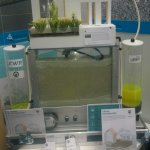 From 10 to 13 May, the Adaptation Futures Conference was held in Rotterdam in the Netherland. Adaptation Futures is the biennial conference of the Global Programme of Research on Climate Change Vulnerability, Impacts and Adaptation (PROVIA). In 2016 the European Commission and the Government of the Netherlands co-host the fourth edition. Adaptation Futures 2016 is where scholars, practitioners, policymakers and business people from all around the world go to connect, learn and inspire. It highlights adaptation practices and solutions for people, governments and businesses. The programme addresses all sectors and all parts of the world. Click to read more
From 10 to 13 May, the Adaptation Futures Conference was held in Rotterdam in the Netherland. Adaptation Futures is the biennial conference of the Global Programme of Research on Climate Change Vulnerability, Impacts and Adaptation (PROVIA). In 2016 the European Commission and the Government of the Netherlands co-host the fourth edition. Adaptation Futures 2016 is where scholars, practitioners, policymakers and business people from all around the world go to connect, learn and inspire. It highlights adaptation practices and solutions for people, governments and businesses. The programme addresses all sectors and all parts of the world. Click to read more
DESSIN meetings in Denmark
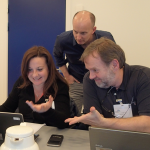 DESSIN partner DHI provided and hosted a MIKE Workbench training to DESSIN partners from 25.-27. of April and a software requirements meeting on the 28. -29. of April at DHI’s offices in Hørsholm, Denmark.
DESSIN partner DHI provided and hosted a MIKE Workbench training to DESSIN partners from 25.-27. of April and a software requirements meeting on the 28. -29. of April at DHI’s offices in Hørsholm, Denmark.
Participants of the training in the use of the software MIKE Workbench included demo site partners (SINTEF, KWR, EG, Cetaqua and NTUA), mature site partners (Cetaqua and EG) and software requirements partners (ECOLOGIC and SINTEF). Participants received training across a spectrum of MIKE Workbench functionalities with a focus on how the software can be used to carry out ecosystem services and sustainability assessments. The training focused on a real-world case study from one of the DESSIN mature sites. Software requirements partners (DHI, ECOLOGIC and SINTEF) also used the training as an opportunity to obtain feedback from the demo site partners on how the existing MIKE Workbench software may be enhanced to meet their needs. Click to read more
Second annual DESSIN magazine available
 The second annual DESSIN magazine is now available for download here.
The second annual DESSIN magazine is now available for download here.
This issue deals with the implementation of the Water Framework Directive at DESSIN’s Emscher demo site, the DESSIN ESS evaluation framework, the successful implementation and future work of the Ecosystems Services concept in the water sector, the progress at the single demo sites, a first stygofauna sampling survey in the Llobregat area and it also contains an interview with Durk Krol about his perception of DESSIN: “The most challenging task is to successfully bring the innovations to society and market”.
Enjoy the read!
DESSIN and the Global Water Research Coalition
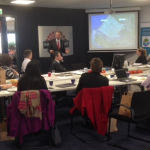 The Global Water Research Coalition (GWRC) visited the Netherlands in April for their semi-annual board meeting. The GWRC is a partnership of watercycle research organisations from the US, the UK, Germany, France, Canada, Singapore, Australia, South-Africa and the Netherlands and a non-profit organisation that serves as the collaborative mechanism for water research. The aim of the GWRC is to leverage funding and expertise amongst the participating research organisations, coordinate research strategies, secure additional funding not available to single country research foundations, and actively manage a centralised approach to global issues. STOWA and KWR, both members of the GWRC, hosted the meeting in KWR’s premises in Nieuwegein.
The Global Water Research Coalition (GWRC) visited the Netherlands in April for their semi-annual board meeting. The GWRC is a partnership of watercycle research organisations from the US, the UK, Germany, France, Canada, Singapore, Australia, South-Africa and the Netherlands and a non-profit organisation that serves as the collaborative mechanism for water research. The aim of the GWRC is to leverage funding and expertise amongst the participating research organisations, coordinate research strategies, secure additional funding not available to single country research foundations, and actively manage a centralised approach to global issues. STOWA and KWR, both members of the GWRC, hosted the meeting in KWR’s premises in Nieuwegein.
Click to read more